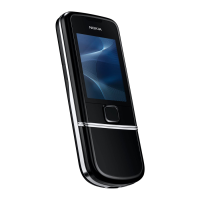General information
10
■ Overview of functions
Your phone provides many functions that are practical for daily use,
such as a calendar, a clock, an alarm clock, a radio, a music player, and a
built-in camera. Your phone also supports the following functions:
• Enhanced data rates for GSM evolution (EDGE), see “Packet data,”
p. 59.
• Extensible hypertext mark-up language (XHTML), see “Web,” p. 81.
• E-mail application, see “E-mail application,” p. 36.
• Java 2 Platform, Micro Edition (J2ME
TM
), see “Applications,” p. 79.
• Bluetooth wireless technology, see “Bluetooth wireless technology,”
p. 58.
• Synchronization of data from another phone without having a SIM
card inserted, see “Data transfer with a device,” p. 61.
• Plug and play online service to get the configuration settings, see
“Switch the phone on and off,” p. 17, and “Configuration,” p. 64.
■ Access codes
Security code
The security code (5 to 10 digits) helps to protect your phone against
unauthorized use. The preset code is 12345. To change the code, and to
set the phone to request the code, see “Security,” p. 65.
PIN codes
The PIN (personal identification number) code and the UPIN (universal
personal identification number) code (4 to 8 digits) help to protect your
SIM card against unauthorized use. See “Security,” p. 65.
The PIN2 code (4 to 8 digits) may be supplied with the SIM card and is
required for some functions.
The module PIN is required to access the information in the security
module. See “Security module,” p. 86.
The signing PIN is required for the digital signature. See “Digital
signature,” p. 88.

